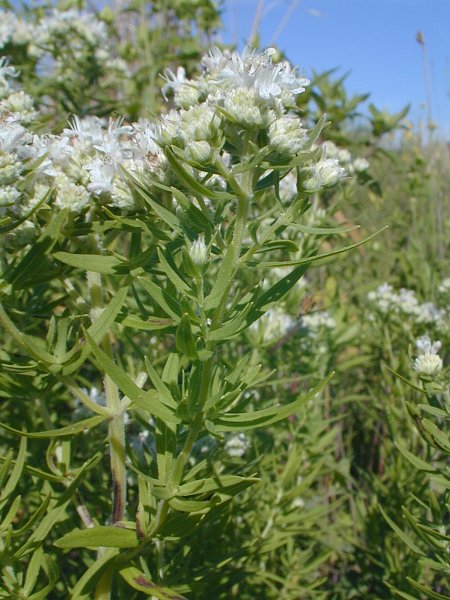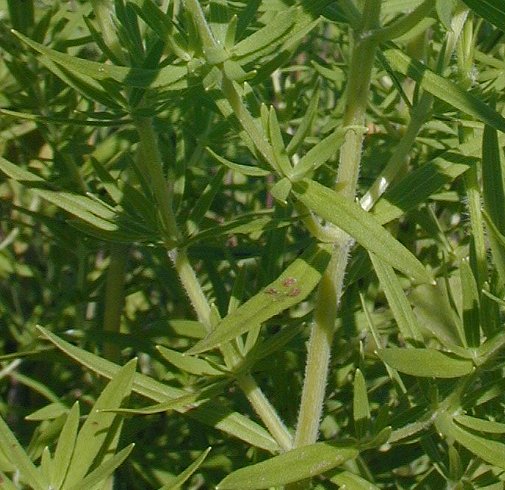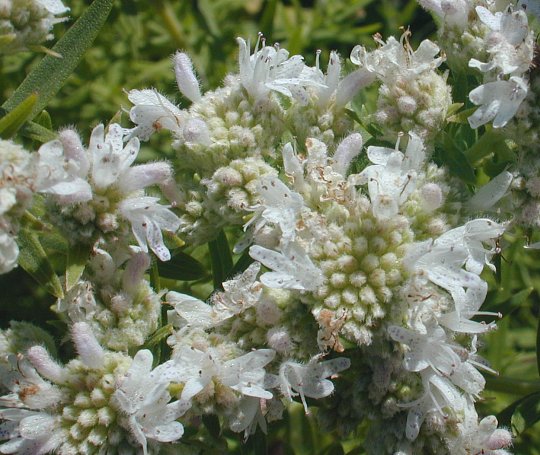Description:
This is
a perennial herbaceous plant up to 3' tall and branching frequently,
often
with a bushy appearance. The green or reddish stems are strongly
four-angled and have scattered white hairs along the ridges. The
opposite leaves are up to 2½" long and narrowly lanceolate or linear.
They are sessile, and have smooth margins. The largest leaves are ¼ -
½" across. When damaged, the foliage releases a strong mint scent.
Numerous flattened
heads of small white flowers (often with purple dots) occur at the ends
of the upper stems.
Each head is up to ¾" across and can contain up to
50 flowers.

However, only a few of these are in bloom at the same time,
beginning with the outer circle of flowers and ending towards the
center. Each tubular flower is about 1/8" long and 2-lipped. The
blooming period occurs during the middle of summer and lasts about a
month. Each small flower produces 4 tiny, finely pitted, dull black
seeds. These seeds are distributed to some extent by the wind. The root
system produces rhizomes, which spread a short distance from the mother
plant. Soon, a small colony of plants are formed vegetatively.
Cultivation:
The preference is full or partial sun, and moist to average conditions.
The soil can contain loam, sand, clay, or gravel – this plant is not
fussy about soil texture. During drought, the lower leaves will turn
yellow and fall off. This plant is easy to grow, and less subject to
foliar disease than some other mints, such as Monarda spp. However,
stressed out plants sometimes succumb to rust.

Range &
Habitat:
The native Common Mountain Mint is widely distributed in Illinois, but
it is uncommon
or absent from southern Illinois and a few western counties (see Distribution
Map). This plant is occasional to locally common in moist to
mesic
black soil prairies. Other habitats include moist sand prairies, moist
meadows in woodland areas, thickets, fens, swamps, and rocky bluffs.
This is probably the most common Mountain Mint in Illinois.
Faunal Associations:
Many insects are strongly attracted to the flowers, including various
bees, wasps, flies, small butterflies, and beetles. Typical visitors
from these groups include honeybees, Cuckoo bees, Halictid bees,
Sphecid wasps, Eumenine wasps, bee flies, Tachinid flies, Wedge-shaped
beetles, and Pearl Cresecent butterflies. Most of these insects seek
nectar. Mammalian herbivores and many leaf-chewing insects apparently
find the mint fragrance of the leaves and stems repugnant, and rarely
bother this plant.

Photographic
Location:
The photographs were taken at a prairie of Parkland College in
Champaign, Illinois.
Comments:
The name 'Mountain Mint' is something of a misnomer, because this plant
and other similar species in this genus do not usually occur in
mountainous habitats. Common Mountain Mint is similar in appearance to Pycnanthemum
tenuifolium (Slender Mountain Mint). It can be distinguished
from the latter species by the white hairs along the ridges of its
stems, and the occurrence of leaves greater than ¼" across. The stems
of Slender Mounntain Mint lack hairs.